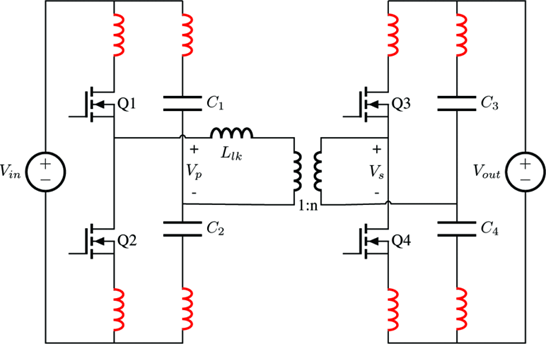Differential Power Processing Architecture for On-Vehicle Photovoltaics




This work presents advancements in power conversion for electric vehicle (EV) integrated photovoltaics (PV), focusing on efficient operation under partial shading and high-frequency constraints. A scalable, low-cost differential power processing (DPP) architecture is proposed for maximizing PV output using the EV’s existing low-voltage battery as a common bus and repurposing the onboard charger for high-voltage interfacing. Each DPP module performs local MPPT without cross-barrier communication and supports bidirectional power flow with synchronous rectification. To address high-frequency switching losses in such systems, a dual active (half) bridge (DAHB) topology is operated in boundary conduction mode, achieving zero-current switching on the high-current side and zero-voltage switching on the high-voltage side. Burst-mode control extends operation across a wide power range. Experimental validation of both the DPP module and the 1 MHz, 40 W DAHB converter demonstrates high efficiency, compact design, and suitability for EV solar integration.
Read More:
Resonant Mode Microinverter for grid-tied PV applications
A novel single-stage LCL resonant microinverter is proposed, that reduces installation and maintenance costs in solar systems. The topology achieves partial ZVS on the primary FETs, full ZVS on the secondary FETs, low reactive power, and current source output characteristics. It is compatible with bidirectional GaN FETs and validated through 500 kHz, 380 W simulations and experiments. Additionally, a method for determining the validity of the fundamental harmonic approximation (FHA) in resonant circuits and wireless power transfer (WPT) systems is introduced. The method, demonstrated with series-series and double-sided LCC topologies, expands the FHA’s applicability range and is validated through a 600 W setup.

Read More:
Switch-Mode & Synchronously Switched Active EMI Filters


Electromagnetic interference (EMI) in the 0.15-30 MHz frequency range is a key challenge. While passive LC filters can occupy up to 1/3 of the power supply’s volume, active EMI filters (AEFs) are effective in reducing filter size and current. Traditional AEFs use linear amplifiers to counteract ripple voltage or current, leading to limited bandwidth and high power consumption. We investigate switch-mode and synchronously switched AEFs as alternatives, which use high-frequency (30-300 MHz) amplifiers to achieve near-100% efficiency and avoid introducing additional interference in the regulated range. Additionally, the design and implementation of ultra-fast isolated gate drivers with 2-8 ns propagation delays (and very high on/off slew rates) is proposed, helping achieve super high control bandwidths for such AEFs.
Read More:
